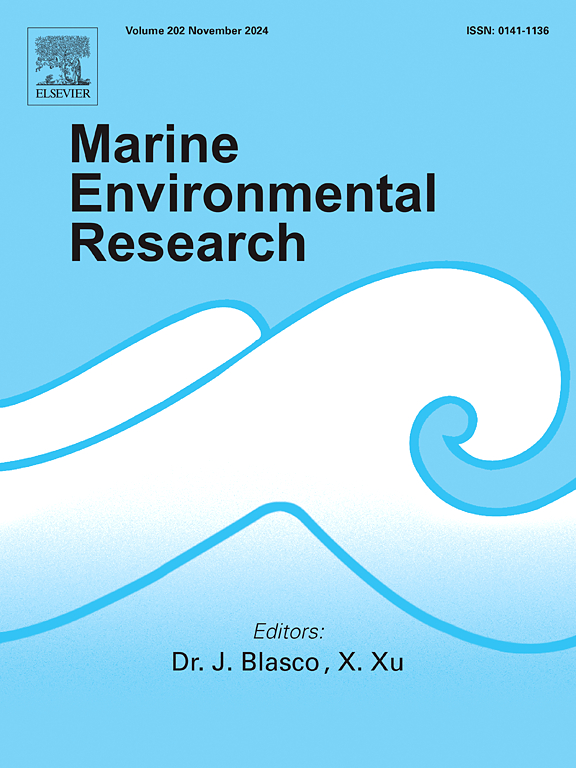Comparative transcriptome analysis reveals the response mechanism of the typical marine ciliate Euplotes vannus to heavy metal cadmium exposure
IF 3
3区 环境科学与生态学
Q2 ENVIRONMENTAL SCIENCES
引用次数: 0
Abstract
Cadmium (Cd) is one of the major heavy metal pollutants. High concentrations of Cd in surface sediments have led to serious damage to marine ecosystems and threatened the health of marine organisms. Euplotes vannus, a marine epiphytic ciliate, is susceptible to Cd in sediments as a model unicellular eukaryote without the cell wall. This study used Euplotes vannus as a test organism to investigate the biotoxicity of Cd and the response mechanisms of marine microorganisms to Cd. The results showed that Euplotes vannus showed high tolerance to Cd2+ (24 h-LC50 = 38.75 mg/L). We found that Cd inhibited the population growth of E. vannus in a dose-dependent manner. This may be due to the cellular Cd2+ uptake leads to a series of negative cellular effects, including DNA damage, protein damage and mitochondrial disruption. These oxidative damages led to a rapidly increased activities of four antioxidant enzymes (SOD, CAT, POD and GSH-PX) in Euplotes vannus. Furthermore, transcriptome analysis indicated that transporter proteins could be involved in Cd2+ efflux, and the expression of genes for DNA repair, energy metabolism, and protein synthesis was also significantly changed. These play a crucial role in stabilizing cellular gene expression, providing energy support and maintaining cell growth. In addition, we found that ribosome biogenesis, glutathione metabolism and mitochondrial biogenesis pathways were significantly enriched. The differential expression of these genes indicates that Cd exposure induces a wide range of post-transcriptional regulatory mechanisms in Euplotes vannus to enhance tolerance to Cd.
镉(Cd)是主要的重金属污染物之一。表层沉积物中高浓度的镉严重破坏了海洋生态系统,威胁着海洋生物的健康。作为一种没有细胞壁的单细胞真核生物,海洋附生纤毛虫 Euplotes vannus 易受沉积物中镉的影响。本研究以Euplotes vannus为试验生物,研究镉的生物毒性和海洋微生物对镉的反应机制。结果表明,Euplotes vannus 对 Cd2+ 具有很高的耐受性(24 h-LC50 = 38.75 mg/L)。我们发现,镉以剂量依赖的方式抑制了万年青的种群生长。这可能是由于细胞对 Cd2+ 的吸收导致了一系列负面的细胞效应,包括 DNA 损伤、蛋白质损伤和线粒体破坏。这些氧化损伤导致万年青中四种抗氧化酶(SOD、CAT、POD 和 GSH-PX)的活性迅速增加。此外,转录组分析表明,转运蛋白可能参与了 Cd2+ 的外流,DNA 修复、能量代谢和蛋白质合成基因的表达也发生了显著变化。这些基因在稳定细胞基因表达、提供能量支持和维持细胞生长方面起着至关重要的作用。此外,我们还发现核糖体生物发生、谷胱甘肽代谢和线粒体生物发生通路也明显富集。这些基因的差异表达表明,镉暴露会诱导大菱鲆体内多种转录后调控机制,从而增强对镉的耐受性。
本文章由计算机程序翻译,如有差异,请以英文原文为准。
求助全文
约1分钟内获得全文
求助全文
来源期刊

Marine environmental research
环境科学-毒理学
CiteScore
5.90
自引率
3.00%
发文量
217
审稿时长
46 days
期刊介绍:
Marine Environmental Research publishes original research papers on chemical, physical, and biological interactions in the oceans and coastal waters. The journal serves as a forum for new information on biology, chemistry, and toxicology and syntheses that advance understanding of marine environmental processes.
Submission of multidisciplinary studies is encouraged. Studies that utilize experimental approaches to clarify the roles of anthropogenic and natural causes of changes in marine ecosystems are especially welcome, as are those studies that represent new developments of a theoretical or conceptual aspect of marine science. All papers published in this journal are reviewed by qualified peers prior to acceptance and publication. Examples of topics considered to be appropriate for the journal include, but are not limited to, the following:
– The extent, persistence, and consequences of change and the recovery from such change in natural marine systems
– The biochemical, physiological, and ecological consequences of contaminants to marine organisms and ecosystems
– The biogeochemistry of naturally occurring and anthropogenic substances
– Models that describe and predict the above processes
– Monitoring studies, to the extent that their results provide new information on functional processes
– Methodological papers describing improved quantitative techniques for the marine sciences.
 求助内容:
求助内容: 应助结果提醒方式:
应助结果提醒方式:


